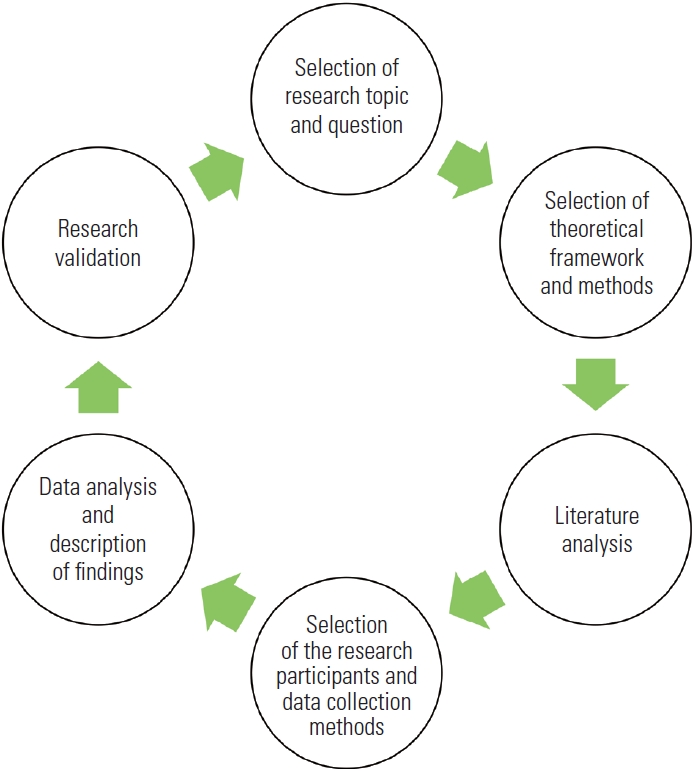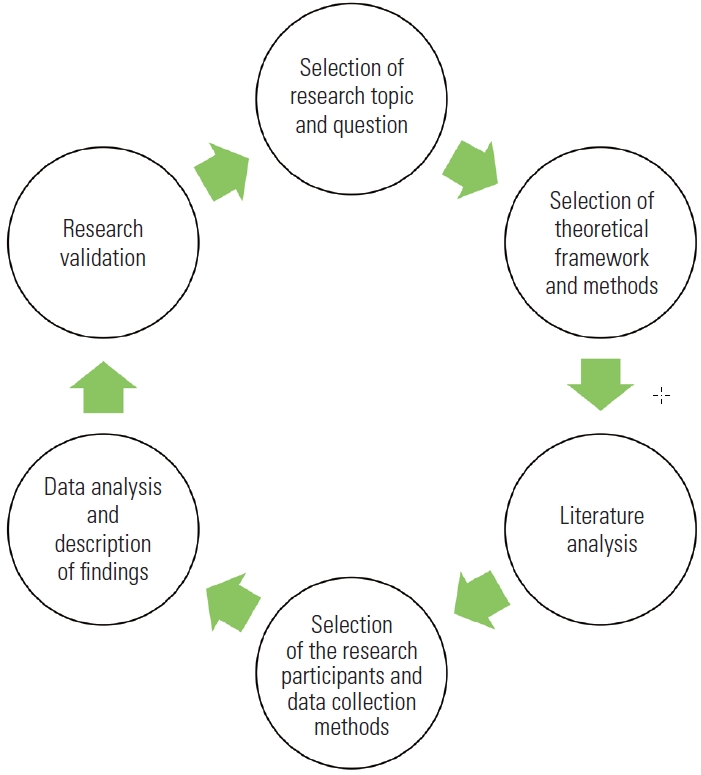Articles
- Page Path
- HOME > J Prev Med Public Health > Volume 56(1); 2023 > Article
-
Review
Qualitative Research in Healthcare: Necessity and Characteristics -
Jeehee Pyo1,2
 , Won Lee3
, Won Lee3 , Eun Young Choi4
, Eun Young Choi4 , Seung Gyeong Jang3
, Seung Gyeong Jang3 , Minsu Ock1,2,5
, Minsu Ock1,2,5
-
Journal of Preventive Medicine and Public Health 2023;56(1):12-20.
DOI: https://doi.org/10.3961/jpmph.22.451
Published online: January 10, 2023
1Department of Preventive Medicine, Ulsan University Hospital, University of Ulsan College of Medicine, Ulsan, Korea
2Ulsan Metropolitan City Public Health Policy’s Institute, Ulsan, Korea
3Department of Nursing, Chung-Ang University, Seoul, Korea
4College of Nursing, Sungshin Women’s University, Seoul, Korea
5Department of Preventive Medicine, University of Ulsan College of Medicine, Seoul, Korea
- Corresponding author: Minsu Ock, Department of Preventive Medicine, Ulsan University Hospital, University of Ulsan College of Medicine, 877 Bangeojinsunhwando-ro, Dong-gu, Ulsan 44033, Korea E-mail: ohohoms@naver.com
Copyright © 2023 The Korean Society for Preventive Medicine
This is an Open Access article distributed under the terms of the Creative Commons Attribution Non-Commercial License (http://creativecommons.org/licenses/by-nc/4.0/) which permits unrestricted non-commercial use, distribution, and reproduction in any medium, provided the original work is properly cited.
Figure & Data
References
Citations

- A qualitative pilot study exploring clients’ and health-care professionals’ experiences with aquatic therapy post-stroke in Ontario, Canada
Andresa R. Marinho-Buzelli, Abirami Vijayakumar, Elizabeth Linkewich, Catherine Gareau, Hasnain Mawji, Zoe Li, Sander L. Hitzig
Topics in Stroke Rehabilitation.2024; 31(1): 86. CrossRef - The Mindfulness-Based Social Work and Self-Care Programme: A Focus Group Study
Alan Maddock, Karen McGuigan, Pearse McCusker, Jane Kellock
Clinical Social Work Journal.2024; 52(1): 48. CrossRef - Surgical De-escalation in Breast Cancer: Qualitative Research Introduces Hope for Patients and Illuminates a Blind Spot Within Blinded Studies
Jose G. Bazan, Benjamin W. Corn
International Journal of Radiation Oncology*Biology*Physics.2024; 118(2): 455. CrossRef - Quantitative, Qualitative, Mixed Methods, and Triangulation Research Simplified
Lina Najib Kawar, Ghada B. Dunbar, Emma M. Aquino-Maneja, Sarah L. Flores, Victoria Rondez Squier, Kim Reina Failla
The Journal of Continuing Education in Nursing.2024; 55(7): 338. CrossRef - Co-designing an intervention using the COM-B model to change an eating behaviour in people living with achalasia
Melika Kalantari, Amelia Hollywood, Rosemary Lim, Majid Hashemi
Frontiers in Medicine.2024;[Epub] CrossRef - Qualitative case study on the disability acceptance experiences of soldiers with disabilities
Haneul Lee, Jeehee Pyo, Minsu Ock, Hyun Joo Kim
International Journal of Qualitative Studies on Health and Well-being.2024;[Epub] CrossRef - Qualitative Comparison of Perceptions Regarding Patient Engagement for Patient Safety by Physicians, Nurses, and Patients
Seung Gyeong Jang, Minsu Ock, Soyoon Kim
Patient Preference and Adherence.2024; Volume 18: 1065. CrossRef - Coping Mechanisms Utilized by Individuals With Drug Addiction in Overcoming Challenges During the Recovery Process: A Qualitative Meta-synthesis
Agus Setiawan, Junaiti Sahar, Budi Santoso, Muchtaruddin Mansyur, Syamikar Baridwan Syamsir
Journal of Preventive Medicine and Public Health.2024; 57(3): 197. CrossRef - Quality of Life of deaf adolescents in high school: A systematic literature review
Abdullah Madhesh
Research in Developmental Disabilities.2024; 151: 104764. CrossRef - Perspectives of Family Caregivers on Healthcare Provided to Older Adults With Hypertension and/or Diabetes Mellitus in Ghana
Edward Appiah Boateng, Rosemary Agyapomah, Isaac Amankwaa, Veronica Millicent Dzomeku, Lawrencia Oppong Peprah
Gerontology and Geriatric Medicine.2024;[Epub] CrossRef - Conducting and Writing Quantitative and Qualitative Research
Edward Barroga, Glafera Janet Matanguihan, Atsuko Furuta, Makiko Arima, Shizuma Tsuchiya, Chikako Kawahara, Yusuke Takamiya, Miki Izumi
Journal of Korean Medical Science.2023;[Epub] CrossRef - “The chameleon among diseases” - an explorative view of sarcoidosis and identification of the consequences for affected patients and relatives using qualitative interviews
Charlotte Hilker, Johanna Weis, Stefanie Ziehfreund, Elizabeth V. Arkema, Tilo Biedermann, Alexander Zink
Orphanet Journal of Rare Diseases.2023;[Epub] CrossRef - Qualitative Research in Healthcare: Data Analysis
Dasom Im, Jeehye Pyo, Haneul Lee, Hyeran Jung, Minsu Ock
Journal of Preventive Medicine and Public Health.2023; 56(2): 100. CrossRef - ‘How is our job affecting us?’ Neonatal Intensive Care Unit healthcare providers and their pregnancy: A descriptive qualitative study
Gaia Dussi, Stefano Bembich, Roberta Crevatin, Sara Buchini, Silvana Schreiber, Livia Bicego, Andrea Cassone, Raffaella Dobrina
Journal of Advanced Nursing.2023; 79(10): 3776. CrossRef - Investigating Functional Impairment in Chronic Low Back Pain: A Qualitative Study from the Patients and Specialists’ Perspectives
Arturo Cuomo, Franco Marinangeli, Alberto Magni, Emiliano Petrucci, Alessandro Vittori, Marco Cascella
Journal of Personalized Medicine.2023; 13(6): 1012. CrossRef - Author Response: Students’ Positive Coping Strategies From Disaster: A Narrative Analysis
Minsu Ock
Journal of Preventive Medicine and Public Health.2023; 56(4): 390. CrossRef - Knowledge, Attitude, and Practice of Qualitative Research Among Health Sciences Faculty
Mohamud Mohamud, Alwaleed A Albarkani, Emad Masuadi, Abdullaziz A Alsahly, Abdulaziz I Alkudairy, Yazeed F Shalabi, Abdulrahman Faqih, Khaled A Alaukili, Saad J Alsahli
Cureus.2023;[Epub] CrossRef - A qualitative study on hope in iranian end stage renal disease patients undergoing hemodialysis
Masoume Rambod, Nilofar Pasyar, Ali Mohammad Parviniannasab
BMC Nephrology.2023;[Epub] CrossRef - Kazakhstani elite athletes’ perspectives on the Tokyo 2020 olympic and paralympic games postponement and their preparation during the COVID-19 pandemic: A qualitative study
Venera Abdulla, Natalya Glushkova, Kulman Nyssanbayeva, Maira Bakasheva, Dominic Sagoe
Performance Enhancement & Health.2023; : 100270. CrossRef
 KSPM
KSPM



 PubReader
PubReader ePub Link
ePub Link Cite
Cite



